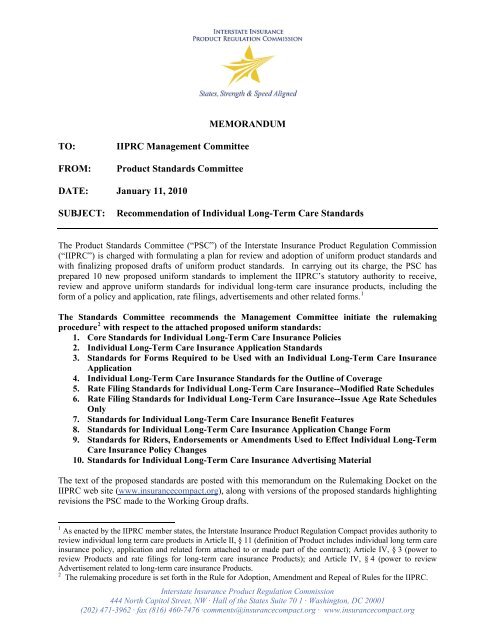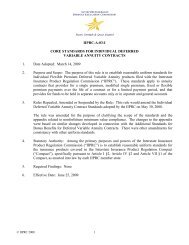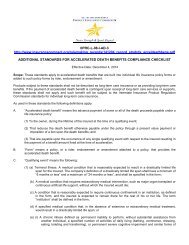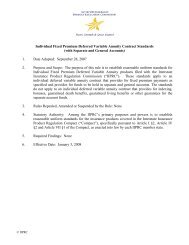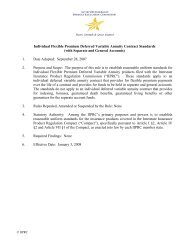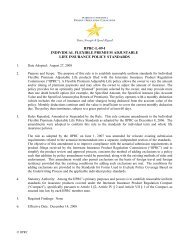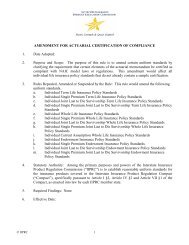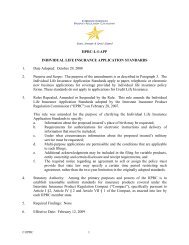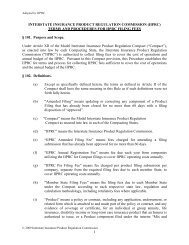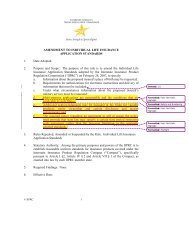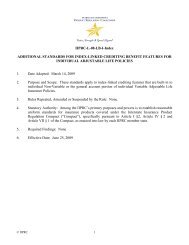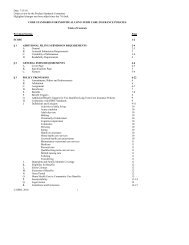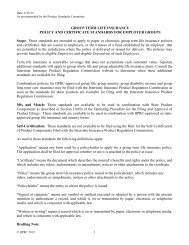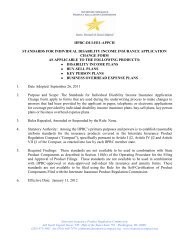Transmittal Memo from Product Standards Committee submitted 1 ...
Transmittal Memo from Product Standards Committee submitted 1 ...
Transmittal Memo from Product Standards Committee submitted 1 ...
You also want an ePaper? Increase the reach of your titles
YUMPU automatically turns print PDFs into web optimized ePapers that Google loves.
MEMORANDUM<br />
TO:<br />
FROM:<br />
IIPRC Management <strong>Committee</strong><br />
<strong>Product</strong> <strong>Standards</strong> <strong>Committee</strong><br />
DATE: January 11, 2010<br />
SUBJECT:<br />
Recommendation of Individual Long-Term Care <strong>Standards</strong><br />
The <strong>Product</strong> <strong>Standards</strong> <strong>Committee</strong> (“PSC”) of the Interstate Insurance <strong>Product</strong> Regulation Commission<br />
(“IIPRC”) is charged with formulating a plan for review and adoption of uniform product standards and<br />
with finalizing proposed drafts of uniform product standards. In carrying out its charge, the PSC has<br />
prepared 10 new proposed uniform standards to implement the IIPRC’s statutory authority to receive,<br />
review and approve uniform standards for individual long-term care insurance products, including the<br />
form of a policy and application, rate filings, advertisements and other related forms. 1<br />
The <strong>Standards</strong> <strong>Committee</strong> recommends the Management <strong>Committee</strong> initiate the rulemaking<br />
procedure 2 with respect to the attached proposed uniform standards:<br />
1. Core <strong>Standards</strong> for Individual Long-Term Care Insurance Policies<br />
2. Individual Long-Term Care Insurance Application <strong>Standards</strong><br />
3. <strong>Standards</strong> for Forms Required to be Used with an Individual Long-Term Care Insurance<br />
Application<br />
4. Individual Long-Term Care Insurance <strong>Standards</strong> for the Outline of Coverage<br />
5. Rate Filing <strong>Standards</strong> for Individual Long-Term Care Insurance--Modified Rate Schedules<br />
6. Rate Filing <strong>Standards</strong> for Individual Long-Term Care Insurance--Issue Age Rate Schedules<br />
Only<br />
7. <strong>Standards</strong> for Individual Long-Term Care Insurance Benefit Features<br />
8. <strong>Standards</strong> for Individual Long-Term Care Insurance Application Change Form<br />
9. <strong>Standards</strong> for Riders, Endorsements or Amendments Used to Effect Individual Long-Term<br />
Care Insurance Policy Changes<br />
10. <strong>Standards</strong> for Individual Long-Term Care Insurance Advertising Material<br />
The text of the proposed standards are posted with this memorandum on the Rulemaking Docket on the<br />
IIPRC web site (www.insurancecompact.org), along with versions of the proposed standards highlighting<br />
revisions the PSC made to the Working Group drafts.<br />
1 As enacted by the IIPRC member states, the Interstate Insurance <strong>Product</strong> Regulation Compact provides authority to<br />
review individual long term care products in Article II, § 11 (definition of <strong>Product</strong> includes individual long term care<br />
insurance policy, application and related form attached to or made part of the contract); Article IV, § 3 (power to<br />
review <strong>Product</strong>s and rate filings for long-term care insurance <strong>Product</strong>s); and Article IV, § 4 (power to review<br />
Advertisement related to long-term care insurance <strong>Product</strong>s.<br />
2 The rulemaking procedure is set forth in the Rule for Adoption, Amendment and Repeal of Rules for the IIPRC.<br />
Interstate Insurance <strong>Product</strong> Regulation Commission<br />
444 North Capitol Street, NW · Hall of the States Suite 70 1 · Washington, DC 20001<br />
(202) 471-3962 · fax (816) 460-7476 ·comments@insurancecompact.org · www.insurancecompact.org
Individual Long-Term Care Insurance <strong>Standards</strong> Recommendation<br />
January 11, 2010<br />
Page 2 of 4<br />
Drafting Process<br />
All of the proposed standards were originally developed by the Long-Term Care Subgroup of the NAIC<br />
National <strong>Standards</strong> (EX) Working Group. Development of long-term care standards by the Working<br />
Group dates back to early 2004, when the initial draft of policy standards was prepared. 3 Every meeting<br />
of the Working Group is open to public participation.<br />
The PSC began its consideration of the individual long-term care insurance standards developed by the<br />
Working Group on November 20, 2008. Since then, the PSC has held at least 54 meetings to review the<br />
proposed standards, amounting to at least 3,930 minutes of review time. The PSC held six meetings in<br />
2009 to receive public comments on the proposed standards: March 5, July 16, October 13, November 3,<br />
November 17 and December 17. Public comments were received <strong>from</strong> Compacting and non-Compacting<br />
states, the Legislative <strong>Committee</strong>, the Industry Advisory <strong>Committee</strong>, the Consumer Advisory <strong>Committee</strong>,<br />
consumer representatives and insurance companies. The PSC is greatly appreciative of the efforts of<br />
legislative, consumer and industry representatives to improve the proposed standards.<br />
Enhanced Consumer Protections<br />
Unique among the IIPRC-eligible product lines, uniform standards for long-term care are required to<br />
provide “the same or greater protections for consumers as, but shall not provide less than, those<br />
protections set forth in the [NAIC] Long-Term Care Insurance Model Act and Long-Term Care Insurance<br />
Model Regulation, respectively, adopted as of 2001.” 4 Some of the enhanced consumer protections in the<br />
proposed standards are as follows.<br />
• For policy forms:<br />
o Exclusions based on mental and nervous disorders are not permitted.<br />
o Exclusions based due to a preexisting condition or disease are limited to loss occurring<br />
within 6 months.<br />
o There are minimum readability requirements for policy forms.<br />
o Only post-dispute, voluntary, binding arbitration is permitted.<br />
• For rate filings:<br />
o There are highly detailed standards for modified rate schedule and rate schedule increase<br />
filings.<br />
o For consumers to be able to make a more informed decision, companies offering a<br />
product with rates that are scheduled to increase up to age 65 must simultaneously offer a<br />
product with issue age rates.<br />
o A rate increase filing may not introduce a rating characteristic that was not relied on in<br />
the initial rate filing. For example, if a company uses unisex rates in the initial filing, it<br />
may not request gender-distinct rates in a rate increase filing.<br />
o All initial rate and rate increase filings are subject to prior approval, which is currently<br />
not the case for all states.<br />
o<br />
o<br />
The insured must receive 60-days notice of a rate increase, rather than 30 or 45 days.<br />
There are specific requirements for premium schedules other than level premium that can<br />
be offered.<br />
• For advertising material:<br />
o There are highly detailed standards for advertising material.<br />
o Consumers must be alerted in advertisements that, unlike other products, the time period<br />
for late premium payments is 65 days.<br />
3 1 PROCEEDINGS OF THE NAIC 187 (2004).<br />
4 Article IV, § 2.
Individual Long-Term Care Insurance <strong>Standards</strong> Recommendation<br />
January 11, 2010<br />
Page 3 of 4<br />
o<br />
o<br />
o<br />
o<br />
o<br />
Mandatory disclosures in advertisements must be set out in close conjunction to the<br />
statement to which they relate.<br />
If company may increase rates on a policy, advertisements for the policy must state that<br />
fact.<br />
Advertising material may not require the consumer to opt out of receiving unsolicited<br />
material.<br />
Advertising that describes an inflation protection option must also describe the<br />
mandatory inflation protection option.<br />
Stricter requirements on sourcing of statistics used in advertising material are established.<br />
Rate Filing Framework<br />
The Working Group and the PSC spent considerable time developing a framework for the proposed rate<br />
filing standards to address the unique nature of a centralized platform for rate review and prior approval.<br />
The PSC believes the centralized yet state-based platform for rate review available through the IIPRC will<br />
contribute to improved speed-to-market for long-term care insurance products. The PSC was also<br />
mindful of the requirement of the Compact that uniform standards for long-term care insurance provide<br />
the same or greater level of consumer protection as the NAIC models, which allow for rates based on the<br />
age of the insured at issue and also for rates with scheduled increases up to age 65.<br />
To gather more information on state requirements and practices for review of long-term care rate filings<br />
for both initial rates and rate increases, the PSC conducted a survey of all states in January 2009. 5 Fortysix<br />
states responded to the survey, including 31 current Compacting states. The survey showed that 100%<br />
of responding states have approved filings for rates based on issue age that are not expected to increase by<br />
duration, but are not guaranteed. The survey also showed that 68% of responding states, including 78%<br />
of responding Compacting states, would hypothetically allow rate structures with scheduled increases up<br />
to age 65 that contain inflation protection. A very revealing fact <strong>from</strong> the survey was that only four states<br />
reported receiving more than five filings containing rate structures other than those based on issue age<br />
that are not expected to increase by duration but are not guaranteed.<br />
The survey results led the PSC to conclude that even though the model allowed for rate structures with<br />
scheduled increases, there appears to be no guidance on this rating structure, and as a result, not a high<br />
level of comfort among the states with reviewing and approving such rates. This conclusion led the PSC<br />
to develop two major approaches for the proposed rate filing standards.<br />
• The proposed standards include one set of standards for rates based on the age of the insured at<br />
issue and another set of standards for rates with scheduled increases up to age 65. The proposed<br />
standards for products with premiums scheduled to increase are called “modified rate schedules.”<br />
The proposed standards for modified rate schedules require the company to file, offer and provide<br />
rates based on the age of the insured at issue if the company elects to offer modified rate<br />
schedules.<br />
• The proposed standards combine requirements for both initial rate filings and rate increase filings<br />
into one document for issue age rate schedules and one document for modified rate schedules.<br />
There are no separate standards for rate increase filings. As a result, this approach means states<br />
that do not want rate increase filings being reviewed and approved by the IIPRC would be opting<br />
out of the proposed standards. The PSC viewed this approach as ensuring that all consumers who<br />
purchase a policy approved by the IIPRC will not have rates or rate increases that are excessive,<br />
inadequate or unfairly discriminatory across state lines.<br />
5 The survey results are posted with the proposed rate filing standards on the Rulemaking Docket on the IIPRC web<br />
site (www.insurancecompact.org).
Individual Long-Term Care Insurance <strong>Standards</strong> Recommendation<br />
January 11, 2010<br />
Page 4 of 4<br />
The approach of creating standards for modified rate schedules calls for each Compacting state to identify<br />
whether modified rate schedules can be used in their state, provided a filing complies with the applicable<br />
standards. This enables states with specific prohibitions or limits on modified rate schedules to still be<br />
able to take advantage of IIPRC standards for long-term care products with rates based on the age of the<br />
insured at issue.<br />
Other Key Decisions<br />
Other key decision points for the PSC in the development of the proposed standards include:<br />
• Recommending standards as a complete suite—Early in the review process, the PSC made a<br />
policy decision to complete the entire suite of uniform standards for individual long-term care<br />
insurance before making a recommendation, because the policy form must be accompanied by the<br />
other forms before it can be made available in the market.<br />
• Mix and match—In general, the proposed standards are not recommended to be available for use<br />
in combination with state-approved forms. The exception is that long-term care riders approved<br />
by the IIPRC may be combined with state-approved life insurance and annuity products.<br />
• Self-certification—The only proposed standards recommended to be available for filing on a selfcertification<br />
basis are the <strong>Standards</strong> for Forms Required to be Used with an Individual Long-<br />
Term Care Insurance Application, which include the Personal Worksheet and Potential Rate<br />
Increase Disclosure Form. This is based on the extent to which these standards and the NAIC<br />
models prescribe the content of the required forms, although companies will have to provide<br />
accurate information regarding historical rate increases in all states, including non-Compacting<br />
states. None of the other proposed standards are recommended to be available for selfcertification.<br />
• Partnership—The proposed standards may be used for products intended to qualify as a Long-<br />
Term Care Partnership Program plan in any state with an operational Partnership program subject<br />
to the company subsequently certifying to the state(s) where the product will be delivered or<br />
issued for delivery that the product meets all Partnership requirements.


